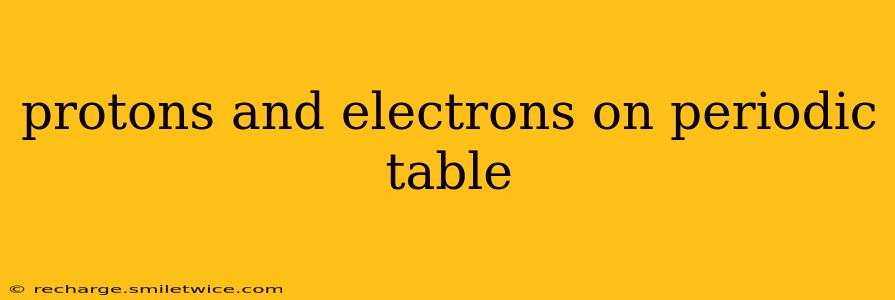The periodic table, a cornerstone of chemistry, organizes elements based on their atomic structure. Understanding the role of protons and electrons within this structure is crucial to grasping the table's organization and the properties of each element. This article will delve into the relationship between protons, electrons, and the periodic table, answering common questions along the way.
What is the relationship between protons and the periodic table?
The fundamental relationship between protons and the periodic table lies in atomic number. Each element's atomic number, displayed prominently above its symbol on the periodic table, represents the number of protons in the nucleus of one atom of that element. This number uniquely identifies each element. Hydrogen (H), with one proton, has atomic number 1; helium (He), with two protons, has atomic number 2; and so on. The periodic table is essentially ordered by increasing atomic number, reflecting the increasing number of protons in the atom's nucleus. This organization is key to understanding the recurring patterns of chemical properties observed in the table.
How many electrons are there in an element?
In a neutral atom (an atom with no net electrical charge), the number of electrons equals the number of protons. This ensures a balance of positive and negative charges. However, atoms can gain or lose electrons, forming ions with a net positive (cations) or negative (anions) charge. The number of electrons in an ion will differ from the number of protons. For example, a sodium ion (Na⁺) has lost one electron, leaving it with 10 electrons despite having 11 protons.
Where are protons and electrons located in an atom?
Protons, along with neutrons (which have no charge), reside in the atom's nucleus, a dense central region. Electrons, on the other hand, occupy the space surrounding the nucleus in regions called electron shells or energy levels. These shells are not fixed paths, but rather represent the probability of finding an electron in a particular region. The further from the nucleus, the higher the energy level of the electron.
How does the number of electrons affect an element's properties?
The number of electrons, particularly those in the outermost shell (valence electrons), dictates an element's chemical properties. These valence electrons participate in chemical bonding, determining how an element interacts with other elements to form compounds. Elements in the same group (vertical column) of the periodic table have the same number of valence electrons, resulting in similar chemical behaviors. For instance, the alkali metals (Group 1) all have one valence electron, leading to their high reactivity.
What determines the arrangement of elements on the periodic table?
The arrangement of elements on the periodic table is based primarily on their atomic number (number of protons) and the resulting electron configuration. Elements with similar electron configurations and hence similar chemical properties are placed in the same group. The periods (horizontal rows) reflect the filling of electron shells. As you move across a period, electrons are added to the same shell until it is full, at which point the next period begins with a new shell.
Do isotopes have different numbers of electrons?
Isotopes of an element have the same number of protons (and therefore the same atomic number) but differ in the number of neutrons. Since the number of electrons in a neutral atom is determined by the number of protons, isotopes of an element have the same number of electrons. The difference in neutrons affects the atom's mass but not its chemical properties (significantly).
Understanding the roles of protons and electrons in the context of the periodic table is crucial for comprehending the organization of the elements and their chemical properties. This knowledge forms the basis for further exploration in chemistry and related fields.
